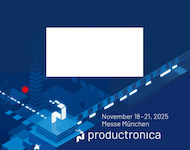
© Taiwan Semiconductor Manufacturing Corp.
Electronics Production |
Is excess capacity in the IC foundry business ahead?
A tremendous surge in capital spending plans among some of the largest pure-play and IDM foundries in 2011 may result in an overcapacity situation in the foundry business by the end of next year, according to IC Insights' McClean Report.
In fact, the combined foundry industry capital spending in 2010 and 2011 is expected to be only 5% less than the foundry spending in the five-year period of 2005-2009!
A big upswing in capital spending, and the overcapacity that typically follows, has been an all-too common theme of some other IC market segments--namely DRAM and flash memory. Now, that situation stands a good chance of spilling over to the IC foundry segment in the near future due to a big increase in 2011 capital spending among several leading foundry suppliers.
Pure-play foundries GlobalFoundries and TSMC announced major increases to their respective capex spending plans for 2011. GlobalFoundries increased its 2011 capex budget to USD 5.4 billion, an increase of 96% compared to 2010. Meanwhile, TSMC boosted its capex budget to USD 7.8 billion for 2011, an increase of 32% over 2010. UMC's USD 1.8 billion capex budget in 2011 is forecast to be flat with 2010, which was up 227% from the USD 551 million the company spent in 2009.
Meanwhile, Samsung's USD 9.2 billion total semiconductor capex budget for 2011 includes a major upgrade to an existing fab or a brand new fab specifically dedicated to its foundry business. Collectively, capital spending among IC foundry players (pure-play and IDM foundries) is expected to grow 43% in 2011 to USD 19.7 billion, up from USD 13.8 billion in 2010, which was a 146% increase over 2009.
In some respects, an increase in capital spending among foundry suppliers is necessary to accommodate the growing wave of semiconductor companies that are migrating to the fab-lite/fabless business model (e.g., ST, Toshiba, etc.). Moreover, in IC Insights' opinion, the big surge in foundry spending in 2010 was justified given the extremely low levels of spending in 2008 and 2009.
However, IC Insights sees a situation developing in which the extremely large amount of capital spending planned for 2011, and possibly 2012 as well, would lead to excess capacity and lower per-wafer revenues for the foundries. Thus, if the major IC foundries continue to spend at 2011 levels in 2012, the foundry industry is highly likely to enter a period of overcapacity before the end of next year.


